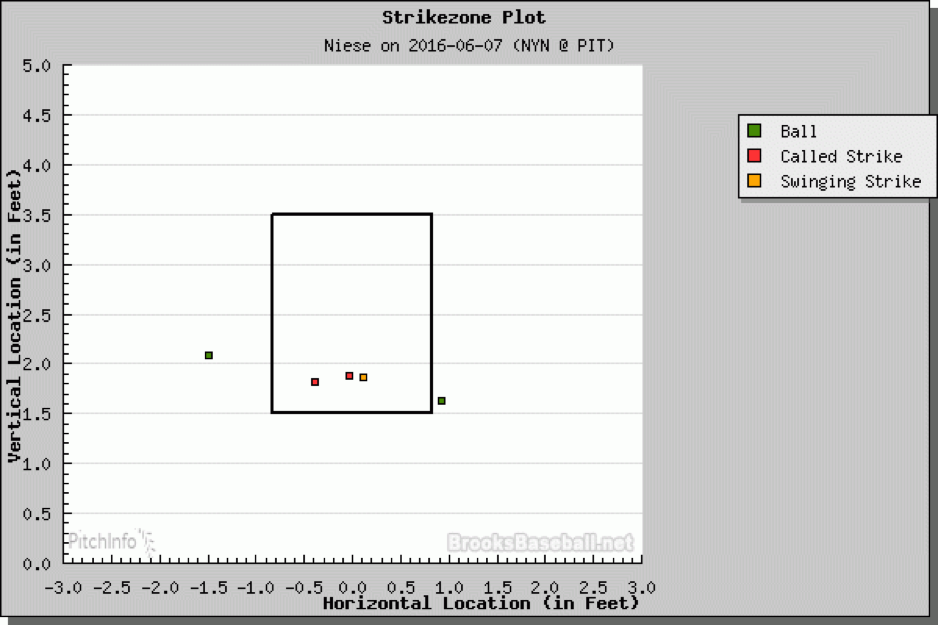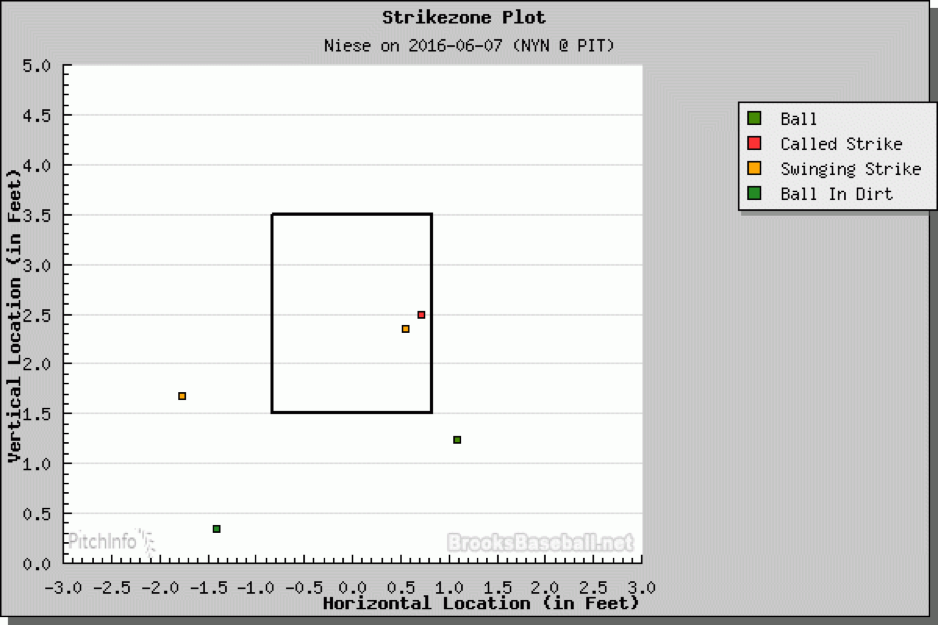In each sport, one event can signify an exit from that worst of five-letter words: slump. For baseball’s hitters, that event is a home run–if you’re in desperate need of positive mojo, a grand slam should catalyze a reversal of fortunes. On Tuesday versus the Pittsburgh Pirates, Michael Conforto found himself in just the position he needed to unstick himself from his 3-for-33 slump. The bases were loaded, the Mets were only down by one, and getting in a good swing would’ve changed the dynamic of the whole game. Jon Niese’s command had wavered after allowing two singles and a walk consecutively, and a positive result would’ve proven the last nine games to be a conquerable, if unsavory, stat line. Instead, this happened:
Strikeout. This at-bat wasn’t in itself worrisome: Niese had regained command and fired off three pitches in the strike zone. No, the concerning trend was a different strikeout earlier in the game, when he swung at a cutter that was nearly a foot horizontally outside the strike zone.
He never should have swung at that pitch, and it got me to thinking about the causes for his slump. Was there an answer to be found in a worsened plate discipline, contrasting my findings for Yoenis Cespedes earlier in the season?
The first places to look–statistically–are walk and strikeout percentages. Leading up to the May 24-present slump, Conforto was walking 8.8 percent of the time and striking out 22.0 percent of the time. From May 24-June 8 inclusive, the rates were 7.6 percent and 32.6 percent, respectively. The walks are lower than the career rates and a 10 percent increase in strikeouts show where the problem lies. There are a few possible answers: Conforto is making less contact, pitchers are throwing more in the zone to him, or he’s swinging even when they’re not in the zone and not making contact. The season numbers to date suggest this latter option is true–he’s swinging at 2.4 percent more pitches outside the zone from 2015 but making contact on nearly 10 percent fewer of these pitches. Pitchers now know that he’s willing to chase. But how willing to chase is he?
To find out, I looked at every plate appearance from May 24 to June 8 and calculated the average distance away from the plate–both horizontally and vertically–for pitches outside the zone that he swung at. I also found the percentage of pitches outside the zone that he swung at. Between May 24 and June 8, Conforto saw 98 pitches outside the strike zone. Of those 98, he swung at 29 of them, good for a 29.5 percent mark–that’s about in line with his overall season numbers, but higher than last season’s. Of those he swung at, he made contact on 16, a 55.1 percent rate. This again is in line with the higher current-season numbers over last season. The average horizontal distance away from the strike zone on the pitches swung at was 0.31 feet, while the average vertical distance away from the strike zone was 0.58 feet. Given how hard it is to make productive contact on pitches that far outside the zone, resisting the urge to swing at these offerings will likely provide an immense benefit.
It’s not as if he’s faced a Kershaw or a Scherzer during this run; there’s been no ace whose pitches seem to have a magnetic attraction to the strikezone. Conforto has faced his share of mortals and has simply chased when there was no need to chase. This is at once comforting and discomfiting: the slump is self-created. His start to the season primed him as the Mets’ biggest offensive threat when the rest of the team wasn’t producing, and now he’s fallen into the same stat line his teammates seem to be producing.
After I began writing this article, Conforto seemed to sense the incoming words when he hit a game-tying two-run home run in the eighth inning of Wednesday’s game versus the Pirates. I started this article outlining the home run as the perfect slump-buster, and we can all hope that his performance will spark a dormant offense. But it’s important to note that the pitch he took for the home run was one he should’ve swung at: right in the zone. It’s the pitches outside that are worrisome. Hopefully he will follow Cespedes’ lead and discover the value of getting on base by whatever means he can.
Photo Credit: Charles LeClaire-USA TODAY Sports



1 comment on “Michael Conforto Can Escape His Slump By Minding The Strike Zone”
Comments are closed.